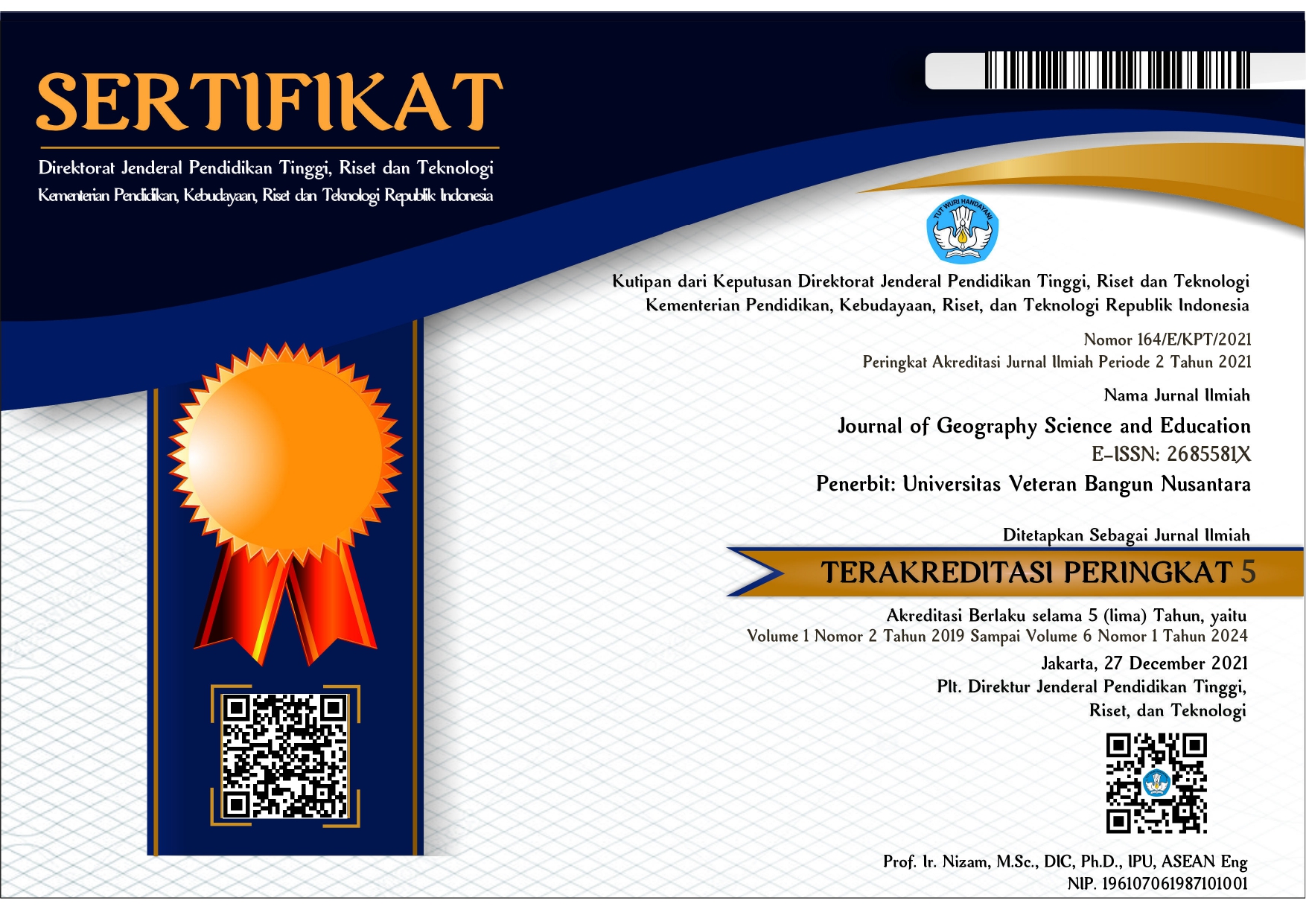THE DISTRIBUTION OF THE RATTAN INDUSTRY TO THE INCOME OF RATTAN CRAFTSMEN IN THE TRANGSAN VILLAGE GATAK DISTRICT SUKOHARJO DISTRICT IN 2020
DOI:
https://doi.org/10.32585/jgse.v3i1.1513Kata Kunci:
Distribution, Income, Rattan IndustryAbstrak
This study aims to determine: 1) Distribution Map of the Rattan Industry in Trangsan Village, Gatak District, Sukoharjo Regency. (2) Region of Origin of Rattan Raw Materials in Trangsan Village, Gatak District, Sukoharjo Regency. (3) Socio-Economic Characteristics of Rattan Industry Craftsmen in Trangsan Village, Gatak District, Sukoharjo Regency. This research uses descriptive qualitative research methodology is a research procedure that produces descriptive data in the form of written or spoken words from people and observable behavior. This study describes the Distribution Map of the Rattan Industry in Trangsan Village, Gatak District, Sukoharjo Regency, the Area of Origin of Rattan Raw Materials in Trangsan Village, Gatak District, Sukoharjo Regency, and the socio-economic characteristics of rattan industry craftsmen in Trangsan Village, Gatak District, Sukoharjo Regency. The data collection technique used is through direct field observation, interviews, questionnaires and documentation Based on the research that has been done, the results of this study are: (1) The results of the distribution of the rattan industry are 101 industries. (2) Regions of origin of rattan raw materials from Sulawesi and Kalimantan. (3) The socio-economic characteristics of rattan craftsmen whose industrial owners are aged 15-64 are 22 people aged> 65, there are 2 people, the highest education level is Bachelor degree, the income level is around 3,000,000 to over 9,000,000. Meanwhile, there are 48 people in the workforce aged 15-64, the highest level of education is SMA, the level of income per week is around 300,000 to 900,000.Unduhan
Referensi
Ananta, Dimas Bagus. 2014. Pengaruh Keberadaan Industri Sirup Jeruk Nipis Peras Terhadap Kondisi Sosial Ekonomi Masyarakat Desa Ciawi gebang Kecamatan Ciawi gebang Kabupaten Kuningan. Skripsi. Universitas Pendidikan Indonesia Bandung.
Ayu Saraswati, Dian dkk. 2016. Analisis Perubahan Luas Lahan dari Pola Persebaran
Pemukiman. Jurnal Geodasi. Universitas Diponegoro. Vol.5. No. 1.Halm.155-163.
Damsar dan indrayani. 2009. Pengantar Sosial Ekonomi. Jakarta: Kharisma Putra Utama
Dia, Sanat. 2016. Karakteristik Sosial Ekonomi Pengrajin Batu Akik di Desa Simpang empat, Kecamatan Lengkiti Kabupaten Ogan Kemiringulu tahun 2015. Universitas Lampung Bandar Lampung.
Moleong. 2012. Metode Penelitian Kualitatif. Bandung. Rosda Karya.
Rahayu, Puji. 2011. Strategi Kelangsungan Usaha Industri Rotan. Universitas Sebelas Maret Surakarta.
Rismiyanti, Arlin. 2019. Analisis Industri Blangkon Terhadap Tingkat Pendapatan dan Pendidikan Pengrajin Di Kampung Potrojayan Kecamatan Serengan Surakarta. Universitas Veteran Bangun Nusantara Sukoharjo.
Roviana, Amanda. 2017. Pola Pendidikan Islam Pada Keluarga Home Industri Rotan di Desa Gatak Kabupaten Sukoharjo. IAIN Surakarta.
Sugiyono. 2017. Metode Penelitian Kuantitatif, Kualitatif dan R & D. Bandung: Alfabeta.
Sugiyono 2017. Metode Penelitian dan Pengembangan. Bandung: Alfabeta
Unduhan
Diterbitkan
Cara Mengutip
Terbitan
Bagian
Lisensi
License and Copyright Agreement
In submitting the manuscript to the journal, the authors certify that:
- They are authorized by their co-authors to enter into these arrangements.
- The work described has not been formally published before, except in the form of an abstract or as part of a published lecture, review, thesis, or overlay journal. Please also carefully read JGSE's Posting Your Article Policy at http://pubs2.ascee.org/index.php/ijele/about/editorialPolicies#custom-5
- That it is not under consideration for publication elsewhere,
- That its publication has been approved by all the author(s) and by the responsible authorities – tacitly or explicitly – of the institutes where the work has been carried out.
- They secure the right to reproduce any material that has already been published or copyrighted elsewhere.
- They agree to the following license and copyright agreement.
Copyright
Authors who publish with Journal of Geography Science and Education agree to the following terms:
- Authors retain copyright and grant the journal right of first publication with the work simultaneously licensed under a Creative Commons Attribution License (CC BY-SA 4.0) that allows others to share the work with an acknowledgment of the work's authorship and initial publication in this journal.
- Authors are able to enter into separate, additional contractual arrangements for the non-exclusive distribution of the journal's published version of the work (e.g., post it to an institutional repository or publish it in a book), with an acknowledgment of its initial publication in this journal.
- Authors are permitted and encouraged to post their work online (e.g., in institutional repositories or on their website) prior to and during the submission process, as it can lead to productive exchanges, as well as earlier and greater citation of published work.
Licensing for Data Publication
Journal of Geography Science and Education use a variety of waivers and licenses, that are specifically designed for and appropriate for the treatment of data:
- Open Data Commons Attribution License, http://www.opendatacommons.org/licenses/by/1.0/ (default)
- Creative Commons CC-Zero Waiver, http://creativecommons.org/publicdomain/zero/1.0/
- Open Data Commons Public Domain Dedication and Licence, http://www.opendatacommons.org/licenses/pddl/1-0/
Other data publishing licenses may be allowed as exceptions (subject to approval by the editor on a case-by-case basis) and should be justified with a written statement from the author, which will be published with the article.
Open Data and Software Publishing and Sharing
The journal strives to maximize the replicability of the research published in it. Authors are thus required to share all data, code or protocols underlying the research reported in their articles. Exceptions are permitted but have to be justified in a written public statement accompanying the article.
The associated persistent identifiers (e.g. DOI, or others) of the dataset(s) must be included in the data or software resources section of the article. Reference(s) to datasets and software should also be included in the reference list of the article with DOIs (where available). Where no domain-specific data repository exists, authors should deposit their datasets in a general repository such as ZENODO, Dryad, Dataverse, or others.
Small data may also be published as data files or packages supplementary to a research article, however, the authors should prefer in all cases a deposition in data repositories.










